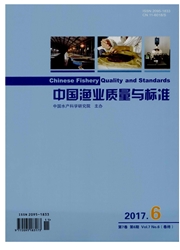

 中文摘要:
中文摘要:
采用镰孢菌选择性培养基,从凡纳滨对虾(Litopenaeus vannarnei)养殖环境中的海水、沉泥、饲料和对虾中分离镰孢菌并进行形态学鉴定。镰孢菌分离株经产毒培养,毒素抽提后,采用薄层层析法进行快速初步筛选,接着对毒素产物进行LC—MS/MS验证,同时阐明对虾养殖环境中产T-2毒素镰孢菌的发生规律。结果表明,对虾养殖环境中共分离出镰孢菌257株,其中饲料中的占26.8%(69/257);沉泥中的占62,6%(161/257);水样中的占6.2%(16/257);对虾体内的占6.2%(11/257)。形态学鉴定表明它们主要为以下4种镰孢菌,比例分别为串珠镰孢菌(Fusariumnzo—niliforme)占11.7%(30/257);梨孢镰孢菌(Fpoae)占5.4%(14/257);尖孢镰孢菌(Foxysporum)占9.7%(25/257);拟枝孢镰孢菌(Fsporotrichioides)占6.6%(17/257);未鉴定种占66.5%(171/257)。薄层层析法发现产毒镰孢菌占10.6%(5/47)。经LC—MS/MS法检测,发现产生的主要毒素为T-2毒素,此外还有未知毒素。本研究为对虾镰孢菌病的有效控制提供基础数据。[中国渔业质量与标准,2014,4(6):59—64]
 英文摘要:
英文摘要:
The Fusarium was isolated by using Fusarium selective medium sampling from sea water, slime, feed and shrimps (Litopenaeus vannamei) in the breeding environment and preliminary identified by morphology method. The toxin extraction was preliminary screened rapidly by a thin layer chromatography after toxin - producing cultivation, and then verified by LC - MS/MS method. The occurrence rules of T -2 toxin - producing Fusarium isolates were illustrated. Results showed that 257 strains of Fusarium were isolated in the breeding environment, which accounted for 26.8% (69/257), 62.6% ( 161/257), 6.2% (16/257) and 6.2% (11/257) in feed, slime, water and prawns, respectively. Fusarium moniliforme , F. poae , F. oxysporum and F. sporotrichioides accounted for 11.7% (30/257), 5.4% ( 14/257), 9.7 % (25/257) and 6.6% ( 17/257 ), respectively. The rest of the Fusarium isolates failed to identify species accounted for 66.5% (171/257) due to no spore' s observation. The toxin -producing Fusarium accounted for 10.6% (5/47) by thin layer chromatography, and toxin products were mainly found T -2 toxins by LC - MS/MS. This study laid the basic data for an effectively control on shrimp Fusarium disease. [ Chinese Fishery Quality and Standards, 2014, 4 (6) :59 - 64 ]
 同期刊论文项目
同期刊论文项目
 同项目期刊论文
同项目期刊论文
 期刊信息
期刊信息
